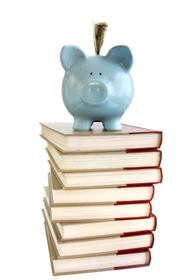Top Rankings
Lynchburg City School District ranks among the top 20% of public school district in Virginia for:
Category
Attribute
Student Attention
Lowest student:teacher ratio (Top 1%)
For the 2025 school year, there are 3 public middle schools serving 1,642 students in Lynchburg City School District. This district's average middle testing ranking is 3/10, which is in the bottom 50% of public middle schools in Virginia.
Public Middle Schools in Lynchburg City School District have an average math proficiency score of 34% (versus the Virginia public middle school average of 52%), and reading proficiency score of 62% (versus the 70% statewide average).
Minority enrollment is 70% of the student body (majority Black), which is more than the Virginia public middle school average of 53% (majority Black and Hispanic).
Overview
This School District
This State (VA)
# Schools
20 Schools
448 Schools
# Students
7,727 Students
312,714 Students
# Teachers
670 Teachers
23,458 Teachers
Student : Teacher Ratio
12:1
12:1
District Rank
Lynchburg City School District, which is ranked within the bottom 50% of all 135 school districts in Virginia (based off of combined math and reading proficiency testing data) for the 2020-2021 school year.
The school district's graduation rate of 78% has decreased from 84% over five school years.
Overall District Rank
#102 out of 135 school districts
(Bottom 50%)
(Bottom 50%)
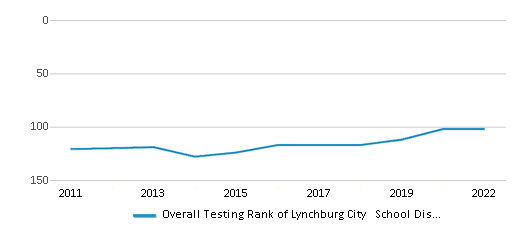
Math Test Scores (% Proficient)
(20-21)36%
54%
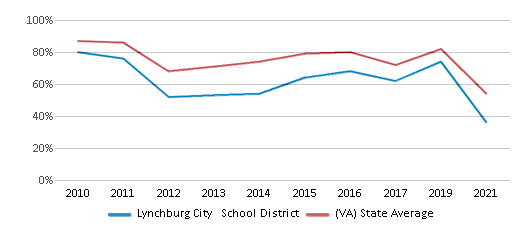
Reading/Language Arts Test Scores (% Proficient)
(20-21)61%
69%
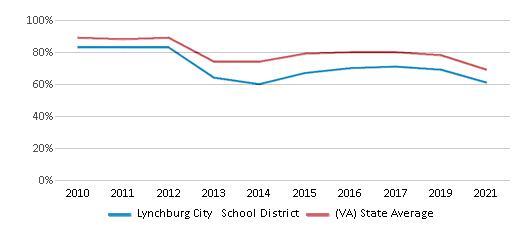
Science Test Scores (% Proficient)
(20-21)46%
59%
Graduation Rate
78%
89%
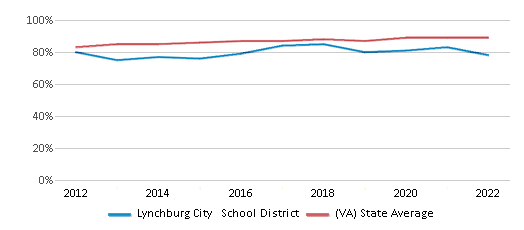
Students by Ethnicity:
Diversity Score
0.66
0.70
# American Indian Students
18 Students
845 Students
% American Indian Students
n/a
n/a
# Asian Students
123 Students
23,246 Students
% Asian Students
2%
7%
# Hispanic Students
688 Students
54,991 Students
% Hispanic Students
9%
18%
# Black Students
3,766 Students
66,738 Students
% Black Students
49%
21%
# White Students
2,341 Students
145,582 Students
% White Students
30%
47%
# Hawaiian Students
1 Student
525 Students
% Hawaiian Students
n/a
n/a
# Two or more races Students
790 Students
20,787 Students
% of Two or more races Students
10%
7%
Students by Grade:
# Students in PK Grade:
305
1,227
# Students in K Grade:
551
2,557
# Students in 1st Grade:
627
2,554
# Students in 2nd Grade:
572
2,836
# Students in 3rd Grade:
547
3,010
# Students in 4th Grade:
586
3,036
# Students in 5th Grade:
560
4,468
# Students in 6th Grade:
546
78,046
# Students in 7th Grade:
540
93,323
# Students in 8th Grade:
556
93,990
# Students in 9th Grade:
657
7,012
# Students in 10th Grade:
594
7,347
# Students in 11th Grade:
576
6,831
# Students in 12th Grade:
510
6,477
# Ungraded Students:
-
-
District Revenue and Spending
The revenue/student of $15,266 in this school district is less than the state median of $15,502. The school district revenue/student has stayed relatively flat over four school years.
The school district's spending/student of $15,171 is less than the state median of $15,257. The school district spending/student has stayed relatively flat over four school years.
Total Revenue
$118 MM
$19,496 MM
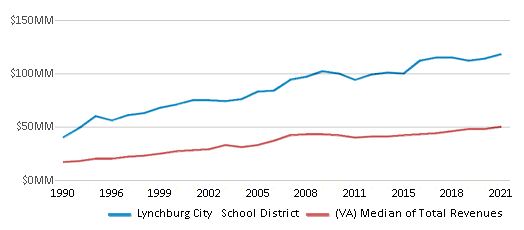
Spending
$117 MM
$19,187 MM
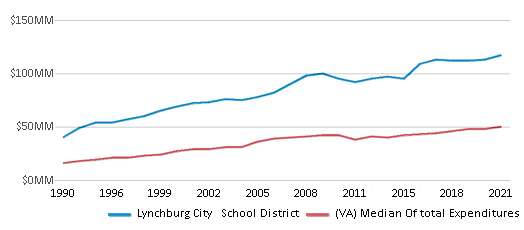
Revenue / Student
$15,266
$15,502
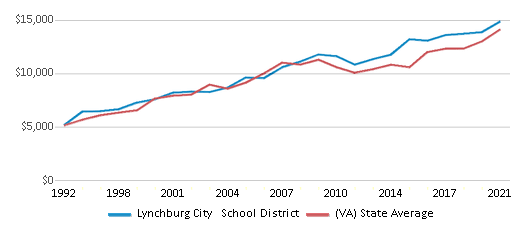
Spending / Student
$15,171
$15,257
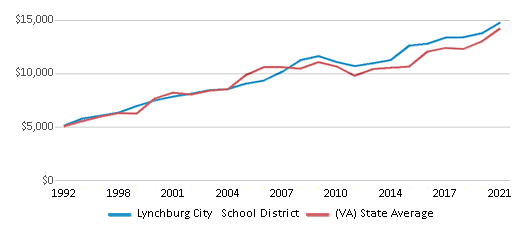
Best Lynchburg City School District Public Middle Schools (2025)
School
(Math and Reading Proficiency)
(Math and Reading Proficiency)
Location
Grades
Students
Rank: #11.
Paul Laurence Dunbar Middle For Innovation
Magnet School
(Math: 37% | Reading: 66%)
Rank:
Rank:
4/
Bottom 50%10
1200 1208 Polk St
Lynchburg, VA 24504
(434) 515-5310
Lynchburg, VA 24504
(434) 515-5310
Grades: 6-8
| 533 students
Rank: #22.
Linkhorne Middle School
(Math: 36% | Reading: 64%)
Rank:
Rank:
3/
Bottom 50%10
2525 Linkhorne Dr
Lynchburg, VA 24503
(434) 515-5330
Lynchburg, VA 24503
(434) 515-5330
Grades: 6-8
| 566 students
Rank: #33.
Sandusky Middle School
(Math: 29% | Reading: 52%)
Rank:
Rank:
2/
Bottom 50%10
805 Chinook Place
Lynchburg, VA 24502
(434) 515-5350
Lynchburg, VA 24502
(434) 515-5350
Grades: 6-8
| 543 students
Recent Articles
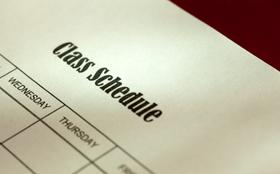
Year-Round Or Traditional Schedule?
Which is more appropriate for your child? A year-round attendance schedule or traditional schedule? We look at the pros and cons.

Why You Should Encourage Your Child to Join a Sports Team
Participating in team sports has a great many benefits for children, there is no doubt. In this article you will learn what those benefits are.

White Students are Now the Minority in U.S. Public Schools
Increasing birth rates among immigrant families from Asia and Central and South America, combined with lower birth rates among white families, means that for the first time in history, public school students in the United States are majority-minority. This shift in demographics poses difficulties for schools as they work to accommodate children of varying language abilities and socio-economic backgrounds.





